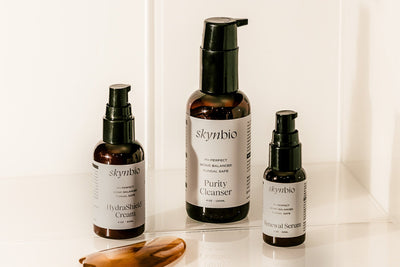Skin issues can be tricky. What looks like acne might not be acne at all, and eczema-like symptoms could be something entirely different. For those with sensitive, reactive skin, correctly identifying the root cause of irritation is crucial for effective treatment.
A common yet often misunderstood issue is fungal skin overgrowth, which can mimic conditions like bacterial infections, acne, or dermatitis. In this post, we’ll explore how to tell the difference between fungal skin overgrowths and other skin conditions, so you can take better care of your skin.
What Are Fungal Skin Overgrowths?
Fungal skin overgrowths occur when Malassezia yeast or other fungi multiply too quickly on the skin, leading to conditions such as:
- ✔ Fungal acne (Malassezia folliculitis)
- ✔ Tinea versicolor (discolored skin patches)
- ✔ Athlete’s foot and jock itch
- ✔ Seborrheic dermatitis (yeast-driven dandruff and facial irritation)
These overgrowths often happen when the skin’s microbiome becomes unbalanced due to factors like:
- 🚨 Humidity & sweat – Fungi thrive in warm, moist environments.
- 🚨 Occlusive products – Heavy oils, fatty acids, and esters can feed yeast.
- 🚨 Weakened immune system – Chronic stress or illness can make skin more prone to fungal overgrowth.
Since fungal conditions can resemble other common skin issues, it’s important to know how to differentiate them and avoid misdiagnosis.
How to Tell If It’s a Fungal Skin Overgrowth
Fungal infections and other skin conditions share similar symptoms, but subtle differences can help you identify the real issue.
1. Fungal Acne vs. Bacterial Acne
Fungal acne (Malassezia folliculitis) is often mistaken for traditional acne, but the two have distinct causes and treatments.
✔ Location:
- Fungal acne: Chest, back, shoulders, forehead.
- Bacterial acne: Primarily face, but can appear elsewhere.
✔ Size & Appearance:
- Fungal acne: Small, uniform, itchy bumps (often in clusters).
- Bacterial acne: Mix of whiteheads, blackheads, and deep cysts.
✔ Triggers:
- Fungal acne worsens with heavy skincare, hot/humid weather, or antibiotics.
- Bacterial acne is influenced by hormones, diet, and clogged pores.
🚀 Key takeaway: If your acne is itchy, uniform in size, and worsens with oils or humidity, it’s likely fungal acne.
2. Fungal Overgrowth vs. Eczema
Fungal infections and eczema both cause red, irritated skin, but they differ in:
✔ Texture & Shape:
- Eczema: Dry, scaly, or flaky patches.
- Fungal infections: Defined borders with small bumps or pustules.
✔ Location:
- Eczema: Inner elbows, knees, hands, and neck.
- Fungal overgrowth: Warm, moist areas (chest, back, groin, skin folds).
✔ Treatment Response:
- Eczema improves with moisturizers & steroid creams.
- Fungal infections worsen with steroids and thrive in moist environments.
🚀 Key takeaway: If moisturizers and steroid creams make it worse, and the rash appears in warm, damp areas, it’s likely fungal.
3. Fungal Infections vs. Dermatitis
✔ Seborrheic Dermatitis (Yeast-Triggered Flaking & Irritation)
- Often caused by Malassezia yeast overgrowth, leading to flaky, greasy patches on the scalp, eyebrows, and nose.
- Chronic condition that responds well to antifungal shampoos and creams.
✔ Contact Dermatitis (Irritation from Allergens or Skincare Ingredients)
- Caused by direct exposure to an irritant (fragrance, detergent, new skincare product, etc.).
- Appears suddenly and resolves once the irritant is removed.
🚀 Key takeaway: If your rash flares after trying a new product, it’s likely contact dermatitis. If you have persistent greasy, flaky patches on your face or scalp, seborrheic dermatitis may be the cause.
4. Fungal Infections vs. Bacterial Infections
✔ Appearance:
- Fungal infections (ringworm, athlete’s foot) appear as red, circular rashes with a clear center.
- Bacterial infections (impetigo, folliculitis) often have pus-filled blisters or crusty lesions.
✔ Spread Rate:
- Fungal infections spread slowly in a circular pattern.
- Bacterial infections spread rapidly and can be painful.
✔ Odor:
- Fungal infections (like athlete’s foot) often have a musty smell.
- Bacterial infections typically don’t produce a noticeable odor.
🚀 Key takeaway: If the rash is slow-growing with a ring-like shape, it’s likely fungal. If painful, fast-spreading, and pus-filled, it’s bacterial.
How to Confirm a Fungal Overgrowth
Identifying fungal overgrowth isn’t always easy, so if you’re unsure:
- ✅ Look for patterns – Does it itch, worsen with humidity, or appear in clusters?
- ✅ Check response to treatments – Does it spread with steroids or improve with antifungals?
- ✅ Consult a dermatologist – A skin culture or biopsy can confirm fungal overgrowth.
Managing & Treating Fungal Skin Overgrowths
If you suspect a fungal infection, effective treatment includes:
- ✔ Use Antifungal Ingredients: Look for tea tree oil, ketoconazole, pyrithione zinc, and Ziziphus Joazeiro Bark Extract (found in Skynbio’s Renewal Serum).
- ✔ Avoid Heavy Oils & Fatty Acids: Malassezia feeds on oils like coconut, olive, and avocado oil—opt for fungal-safe alternatives like squalane and MCT oil.
- ✔ Keep Skin Dry: Fungi thrive in moist environments—dry skin thoroughly after sweating or showering.
- ✔ Choose Microbiome-Safe Skincare: Harsh cleansers strip the skin, making it vulnerable to fungal overgrowth. Use gentle, pH-balanced formulas to maintain skin health.
The Skynbio Difference: Fungal-Safe, Microbiome-Conscious Skincare
At Skynbio, we take a science-backed approach to skin health, focusing on formulations that support your microbiome—without feeding harmful overgrowths.
- ✔ Fungal-Safe & Microbiome-Friendly – Free from fatty acids, esters, and occlusive oils that can worsen fungal conditions.
- ✔ Barrier-Repairing Actives – We use ceramides, niacinamide, and advanced hydrators to restore & strengthen compromised skin.
- ✔ Targeted Solutions – Every ingredient is thoughtfully selected to nourish your skin while preventing overgrowths.
Final Thoughts: Identify & Treat the Root Cause
If you’ve struggled with persistent breakouts, irritation, or unexplained rashes, fungal overgrowth could be the missing link. Correctly identifying the condition is key to choosing the right treatments and skincare routine.
💡 Still using basic fungal-safe skincare? Upgrade to Skynbio—where science meets microbiome health.




